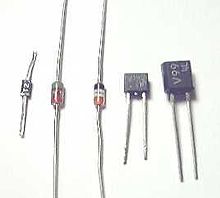Capacitance diode
The capacitance diode or varicap , also varactor or tuning diode called, is a electronic semiconductor - component . By changing the applied voltage, a variation in capacity of 10: 1 can be achieved. This means that an electrically controllable capacitance is available that has largely replaced the considerably larger variable capacitors that were previously used .
function
The pn junction of a diode has a capacitance that depends on the width of the space charge zone . If a diode is operated in the reverse direction, a charge carrier depletion zone is created at the pn junction, where an electric field also builds up due to the lack of charge carriers. As the voltage rises, the width of the charge-free zone increases, so the capacitance decreases. Capacities in the range from 3 pF to 300 pF can be achieved by suitable doping . The maximum reverse voltage is about 30 V .
application
The capacitance diode is used to tune resonant circuits in filters and oscillator circuits , for example instead of variable capacitors or variable inductances ( variometers ) for frequency selection in radio receivers (e.g. radios , television receivers ).
In addition, capacitance diodes connected to LC resonant circuits are used for automatic fine tuning ( AFC ) in receivers or for frequency modulation in FM transmitters.
The fast frequency control in phase-locked loop circuits (PLL) often uses capacitance diodes. These PLL are a core component of all radios and cell phones .
Before transistors were developed around the year 1970 with which one could generate power of a few watts above 200 MHz, one made do with coolable capacitance diodes (varactors) to multiply the frequency from 140 MHz to 420 MHz, for example. The distortion of a sinusoidal voltage has been exploited by the strongly non-linear characteristic that occurs when varactor diodes are operated with more than 20 V AC. By using resonant circuits appropriately, it was possible to filter out the desired harmonics.
Adjustment of LC resonant circuits
To adjust the frequency of LC resonant circuits , the voltage (polarized in reverse direction) is used to set the capacitance of the diode, which is connected in parallel with the coupling capacitor to the capacitor C. Due to the inductance , the oscillating circuit is separated from the voltage source in terms of alternating current. It can usually be replaced by a high resistance in the range of 100 kOhm. The HF voltage applied to the diode must be 3 to 4 orders of magnitude below the applied control voltage, otherwise the resonant circuit will be detuned by the HF voltage, which causes non-linearities and thus intermodulation.
The coupling capacitor separates the control voltage of the diode from the resonant circuit.
A selection must be made so that it does not affect the resonance frequency . Then:
If it is still , then the formula simplifies to:
The anti-series connection of two junction capacitances parallel to the resonant circuit saves the coupling capacitor and reduces the modulation of the capacitance diode by the HF. The reason is that the control voltage is applied to both diodes in the same way (via L and L B ), but the HF is applied with opposite polarity (because it is connected in an antiserial manner) and thus the two changes in capacitance largely cancel each other out.
Capacitance diodes cannot be used to tune resonant circuits with high HF voltages, since their capacitance is voltage-dependent and the maximum reverse voltage is limited. Furthermore, their temperature dependency must be taken into account.
literature
- Ulrich Tietze, Christoph Schenk, Eberhard Gamm, semiconductor circuit technology , Springer 2002, 12th edition, ISBN 3540428496
Web links
- Data sheet of a capacitance diode, Philips / NXP Varicap Diode BB 212 [1]














